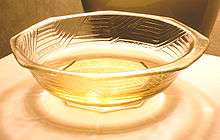Mirin

Mirin (味醂 or みりん) is an essential condiment used in Japanese cuisine. It is a type of rice wine similar to sake, but with a lower alcohol content and higher sugar content.[1] The sugar content is a complex carbohydrate that forms naturally during the fermentation process; no sugars are added. The alcohol content is further lowered when the liquid is heated.
There are three general types of mirin. The first is hon mirin (literally: true mirin),[2] which contains approximately 14% alcohol and is produced by a forty- to sixty-day mashing (saccharification) process.[3][4] The second is shio mirin, which contains alcohol as low as 1.5% to avoid alcohol tax.[5] The third is shin mirin (literally: new mirin),[6] or mirin-fu chomiryo (literally: mirin-like seasoning),[7] which contains less than 1% alcohol yet retains the same flavor.
In the Edo period, mirin was consumed as Amazake.[8] Otoso, traditionally consumed on Shōgatsu, can be made by soaking a spice mixture in mirin.[9]
In the Kansai style of cooking, mirin is briefly boiled before using, to allow some of the alcohol to evaporate, while in the Kantō regional style, the mirin is used untreated. Kansai-style boiled mirin is called nikiri mirin (煮切り味醂)[10] (literally: thoroughly boiled mirin).
Mirin is used to add a bright touch to grilled (broiled) fish or to erase the fishy smell. A small amount is often used instead of sugar and soy sauce. It should not be used in excess, however, as its flavor is quite strong. It is sometimes used to accompany sushi. Mirin is used in teriyaki sauce.[7]
November 30 has been designated the Day of hon-mirin by the mirin industry because in Japanese wordplay the date words sound like '11' (いい, good) and '30' (みりん, mirin).[4]
See also
- Japanese flavorings
- michiu — Chinese rice wine
References
- ↑ Shimbo, Hiroko; Shimbo Beitchman (2000). The Japanese Kitchen: 250 Recipes in a Traditional Spirit. Ming Tsai. Harvard Common Press. p. 75. ISBN 978-1-55832-177-9.
- ↑ Yamaguchi, Roy; Joan Namkoong; Maren Caruso (2003). Hawaii Cooks: Flavors from Roy's Pacific Rim Kitchen. Ten Speed Press. p. 19. ISBN 978-1-58008-454-3.
- ↑ 本みりんの知識 (in Japanese). honmirin.org. Retrieved 10 August 2013.
- 1 2 11月30日 は 「本みりんの日」 (in Japanese). Retrieved 10 August 2013.
- ↑ "Diversified uses of Mirin". Taiwan News. Archived from the original on 2009-01-06. Retrieved 2009-01-07.
- ↑ Telford, Anthony (2003). The Kitchen Hand: A Miscellany of Kitchen Wisdom. Allen & Unwin. p. 153.
- 1 2 Shimbo, Hiroko; Shimbo Beitchman (2000). The Japanese Kitchen: 250 Recipes in a Traditional Spirit. Ming Tsai. Harvard Common Press. p. 77. ISBN 978-1-55832-177-9.
- ↑ Chiba, Machiko, J. K. Whelehan, Tae Hamamura, Elizabeth Floyd (2005). Japanese Dishes for Wine Lovers. Kodansha International. p. 12. ISBN 978-4-7700-3003-0.
- ↑ Gauntner, John (2001-12-31). "An o-tososan a year keeps the doc away". The Japan Times. Archived from the original on 2009-01-07. Retrieved 2009-01-07.
- ↑ Tsuji, Shizuo; Mary Sutherland; Ruth Reichl; Yoshiki Tsuji (2007). Japanese Cooking: A Simple Art. Kodansha International. p. 219. ISBN 978-4-7700-3049-8.